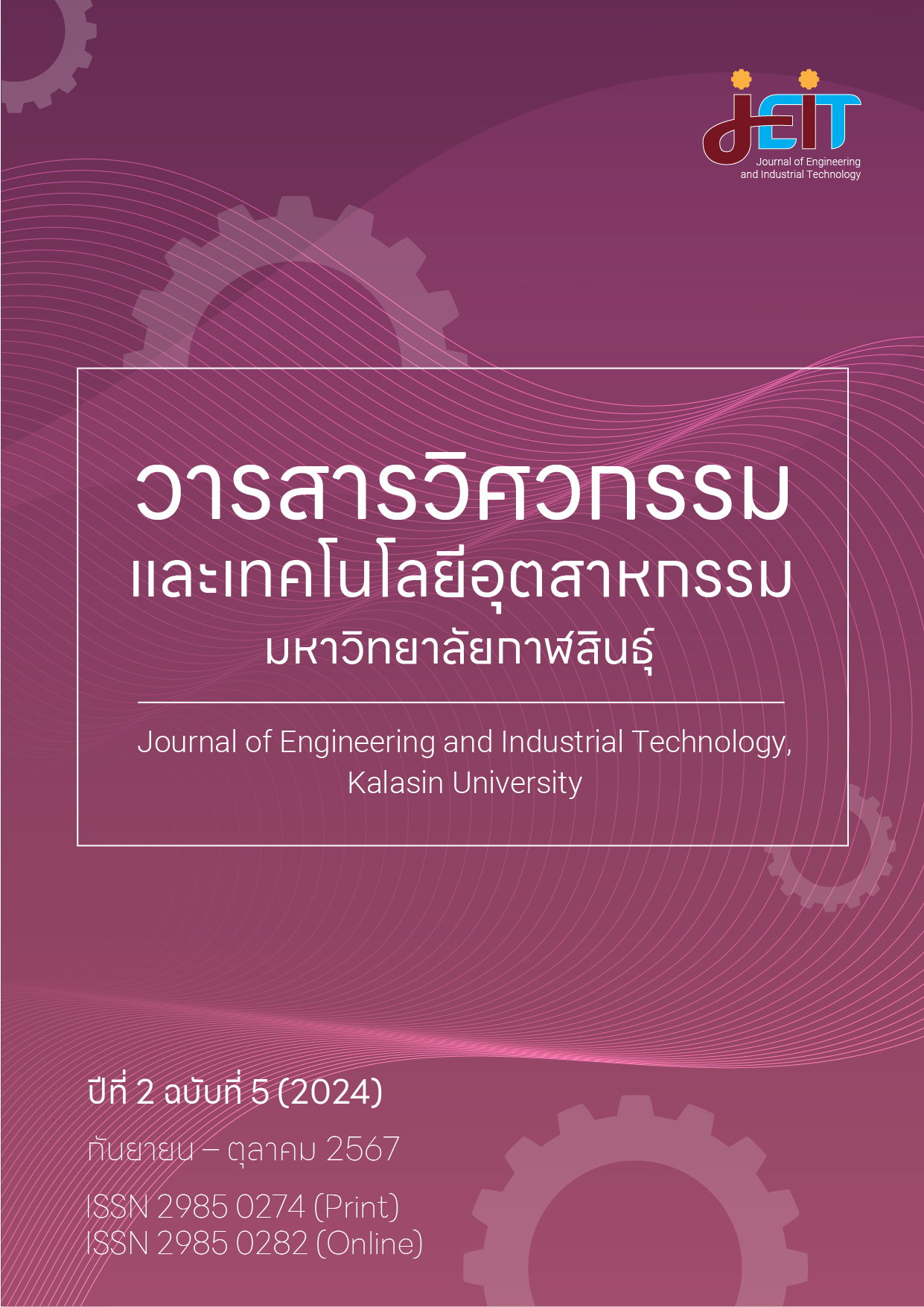Design and Study on Efficiency of Air Conditioning Unit using Thermoelectric for Use in Open Air Electric Vehicles
DOI:
https://doi.org/10.14456/jeit.2024.21Keywords:
Air Conditioning, Thermoelectric, Coefficient of performance, Peltier, Open air electric vehiclesAbstract
This research focuses on the design and performance evaluation of an air conditioning system using Peltier modules in open air electric vehicles to enhance passenger comfort. The experiments were conducted under three seasonal conditions summer, rainy season, and winter. The data collected includes temperature, wind speed, relative humidity, and the system's energy consumption. The comfort analysis revealed that in summer, the system can reduce the air temperature from the fan by 5°C below the ambient air temperature, while in the rainy season and winter, the temperature reductions were 3°C to 4°C. Passengers seated approximately 0.5 meters from the fan felt comfortable in both summer and rainy conditions, though they reported feeling slightly cold during winter. The Coefficient of Performance (COP) of this air conditioning system ranged from 0.0196 to 0.0303, which is comparable to studies on two-stage thermoelectric cooling systems with optimized geometry and current control, yielding COP values between 0.02 and 0.04. Research aimed at enhancing the performance of solar panels using thermoelectric cooling reported a COP of approximately 0.025 to 0.035. Thermoelectric systems typically exhibit lower COP values compared to traditional compressor and absorption cooling systems, with refrigerants like R134a achieving COPs between 3.0 and 3.5. However, this thermoelectric air conditioning system offers several advantages.
References
[1] B. O. Bolaji, M. A. Akintunde, and T. O. Falade, "Comparative analysis of performance of three ozone-friendly HFC refrigerants in a vapour compression refrigerator," Journal of Sustainable Energy & Environment, vol. 2, pp. 61-64, 2011.
[2] H. Tan, H. Fu, and J. Yu, "Evaluating optimal cooling temperature of a single-stage thermoelectric cooler using thermodynamic second law," Applied Thermal Engineering, vol. 123, pp. 845-851, 2017.
[3] L. Zhu and J. Yu, "Optimization of heat sink of thermoelectric cooler using entropy generation analysis," International Journal of Thermal Sciences, vol. 118, pp. 168-175, 2017.
[4] N. Panigrahi, K. Venkatesan, and M. Venkata Ramanan, "Performance study of thermoelectric cooler using multiphysics simulation and numerical modelling," International Journal of Ambient Energy, 2019.
[5] E. Fong, T. T. Lam, W. D. Fischer, and S. W. K. Yuan, "Analytical approach for study of transient performance of thermoelectric coolers," Journal of Thermophysics and Heat Transfer, vol. 33, pp. 96-105, 2019.
[6] Y. M. Seo, M. Y. Ha, S. H. Park, G. H. Lee, Y. S. Kim, and Y. G. Park, "A numerical study on the performance of the thermoelectric module with different heat sink shapes," Applied Thermal Engineering, vol. 128, pp. 1082-1094, 2018.
[7] Y. Qin, B. Qin, D. Wang, C. Chang, and L. Zhao, "Solid-state cooling: thermoelectrics," Energy & Environmental Science, vol. 15, pp. 4527-4541, 2022.
[8] A. Nemati, H. Nami, M. Yari, and F. Ranjbar, "Effect of geometry and applied currents on the exergy and exergoeconomic performance of a two-stage cascaded thermoelectric cooler," International Journal of Refrigeration, vol. 85, pp. 1-12, 2018.
[9] H. S. Dizaji, S. Jafarmadar, S. Khalilarya, and S. Pourhedayat, "A comprehensive exergy analysis of a prototype Peltier air-cooler; experimental investigation," Renewable Energy, vol. 131, pp. 308-317, 2019.
[10] X. Cui and T. Hu, "Robust predictive thermal management strategy for lithium-ion battery based on thermoelectric cooler," Applied Thermal Engineering, vol. 221, 2023.
[11] E. A. Fawzy, S. I. Lee, S. G. Hong, and W. Choi, "Hybrid cooling techniques to improve the performance of solar photovoltaic modules," Solar Energy, vol. 245, no. 2, pp. 254-264, 2022.
[12] K. Ma, Z. Zhengxing, and W. Wei, "Design and experimental study of an outdoor portable thermoelectric air-conditioning system," Applied Thermal Engineering, vol. 219, 2023.
[13] Y. A. Cengel and M. A. Boles, Thermodynamics: An Engineering Approach, 9th ed., New York, NY: McGraw-Hill Education, 2019.
[14] V. Olgyay, Design with Climate: Bioclimatic Approach to Architectural Regionalism, Princeton, NJ: Princeton University Press, 1963.
[15] M. Kosir, "Bioclimatic potential: A way to determine climate adaptability," in Climate Adaptability of Buildings: Bioclimatic Design in the Light of Climate Change, M. Košir, Ed., Cham: Springer International Publishing, 2019.
Downloads
Published
How to Cite
Issue
Section
Categories
License
Copyright (c) 2024 Journal of Engineering and Industrial Technology, Kalasin University

This work is licensed under a Creative Commons Attribution-NonCommercial-NoDerivatives 4.0 International License.
ลิขสิทธิ์ของวารสาร
เนื้อหาและข้อมูลในบทความที่ลงตีพิมพ์ในวารสารศูนย์ดัชนีการอ้างอิงวารสารไทย ถือเป็นข้อคิดเห็นและความรับผิดชอบของผู้เขียนบทความโดยตรงซึ่งกองบรรณาธิการวารสาร ไม่จำเป็นต้องเห็นด้วย หรือร่วมรับผิดชอบใด ๆ
บทความ ข้อมูล เนื้อหา รูปภาพ ฯลฯ ที่ได้รับการตีพิมพ์ในวารสารศูนย์ดัชนีการอ้างอิงวารสารไทย ถือเป็นลิขสิทธิ์ของวารสารศูนย์ดัชนีการอ้างอิงวารสารไทย หากบุคคลหรือหน่วยงานใดต้องการนำทั้งหมดหรือส่วนหนึ่งส่วนใดไปเผยแพร่ต่อหรือเพื่อกระทำการใด จะต้องได้รับอนุญาตเป็นลายลักอักษรจากวารสารศูนย์ดัชนีการอ้างอิงวารสารไทยก่อนเท่านั้น


